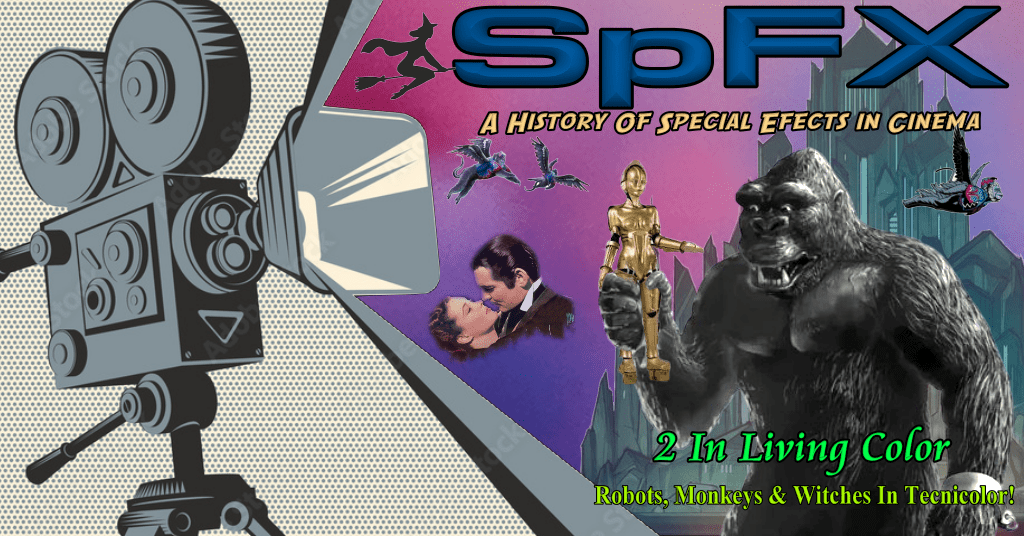Following the release of Lost World, the special effects of the day would change and evolved. One of the most significant evolutions to film came in 1927 with The Jazz Singer. This film introduced sound into movies and started the time of talkies, as they were known, then. At the same time, Fritz Lang released a revolutionary movie called Metropolis.
Metropolis is described (by Wikipedia) as a science-fiction expressionist drama film. It was based on a novel of the same name, written by Thea von Harbou. Filming for Metropolis took place over 17 months at a cost equivalent to $21 Million, in today’s money. Effects for the film were done by German cinematographer, Eugen Schüfftan, and involved miniatures and a very specific camera technique using mirrors. The Schüfftan Technique employed mirrors to make it appear as though the performers were interacting with miniatures.
Another effect of Metropolis included the Maschinenmensch, a robot built by a character in the film. To make the robot, a full-body plaster cast was taken of the actress and costuming was then built around it. The costume made for actress, Brigitte Helm, allowed very little movement but made the transformation of the robot into a real person an exceptional visual.
Almost every science-fiction film to follow owes some of its success to Metropolis and the effects pioneered in the film.
James Whale changed the cinematic landscape at the beginning of the 1930s with the film, Frankenstein. This was the first film to employ a technique where a realistic background was painted on a sheet of glass but leaving a blank space where the film’s action occurred. This effect was called glass matte painting and Frankenstein pioneered a technique which would be used in 1977 on an obscure film a few people might have heard of, Star Wars: A New Hope.
(A glass matte painting from a little sci-fi film in the 70s.)
(The finished piece from “Star Wars: A New Hope.”)
Willis O’Brien, one of the greatest special effects technicians would be called upon in 1933 to lend his talent to King Kong. Rear-screen projection would provide many of the film’s backgrounds while wire-work and stop motion animation would give the film much of its action sequences. O’Brien’s animation gave audiences one of the most noticeable scenes, where the lead character takes shots at flying planes while hold to the Empire State Building.
O’Brien and his assistant, Buzz Gibson, worked on the stop motion pieces. Because of an ever-changing filming schedule, a surface gauge was used to prevent inconsistencies in lighting of the miniatures. The scene between King Kong and the tyrannosaurus took seven full weeks to complete.
One of King Kong‘s most difficult effects was an overall challenge of making live-action and stop motion appear seamless. The Dunning process, invented by Carroll H. Dunning, used filtered blue and yellow lights. The black-and-white film used bi-packing, a process where two strips of film would be used at the same time. These two processes made it possible to have actors interacting with miniatures. Frank D. Williams invented a process utilizing an optical printer. This was a machine using one or more projectors linked to a movie camera, allowing the filmmaker to re-film one or more pieces of film. The Williams process was used in the scene where King Kong pushes the gates open. Using these different processes on one film made King Kong a stand-out of its time.
(Real actors appear to cross a log being rocked by a miniature model of Kong.)
The close of the 1930s would introduce another revolutionary effect to film audiences. Primary director, Victor Fleming would bring the effect of color to the screen with The Wizard of Oz.
The first version of what was called Technicolor dates back to 1916. Technicolor (according to Wikipedia) uses “three black and white films running through a special camera (3-strip Technicolor or Process 4)” Each of the black and white strips recorded a different color, and the strips would be processed together. Technicolor uses brilliant, often garish, color which surpasses the red-green spectrum of previous films. It did not require any additional projection equipment.
(The “seam” of the matte painting of the Emerald City can be seen at the point the poppies end.)
Another film to utilize the Technicolor process to great effect was 1939’s Gone With the Wind.
This was a leader in the idea of virtual reality. Artist, Jack Cosgrove, and his assistants worked with matte painting on 30-40 inch glass panels. These panels, referred to as Cosgrove shots, were combined with the film’s footage to create a location for the action. Hundreds of these Cosgrove shots were produced, including the O’Hara homestead of Tara. While the main set was built, matte paintings of the surrounding sky and trees were added to the film’s setting and background. The long shot of carriages entering Twelve Oaks is also a combination of matte paintings and film footage. Guests arriving to Twelve Oaks used an actual entrance built on a sound stage. Landscaping, house columns, windows, and vines growing over everything were created using matte paintings, or Cosgrove shots.
(An effect achieved by using glass matte painting.)
Cameras using Technicolor were difficult to transport and needed color consultants to get the finished product right. The process also required twice as much lighting to get a scene right. In order to capture the correct visual, Gone With the Wind would require technical advisors and a team which could give producer, David O. Selznick, the richness he wanted. Filming for the film began January 26, 1939 and ended on July 1 of the same year. Lee Garmes, the original cinematographer for the film, was fired because he wanted a more “subdued” scheme. Technicolor made the rich, vibrant colors the film is known for, possible.
The last Technicolor feature film would be produced in 1955.
